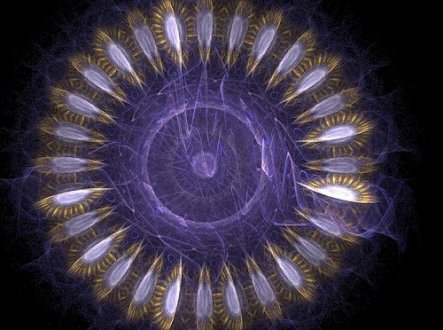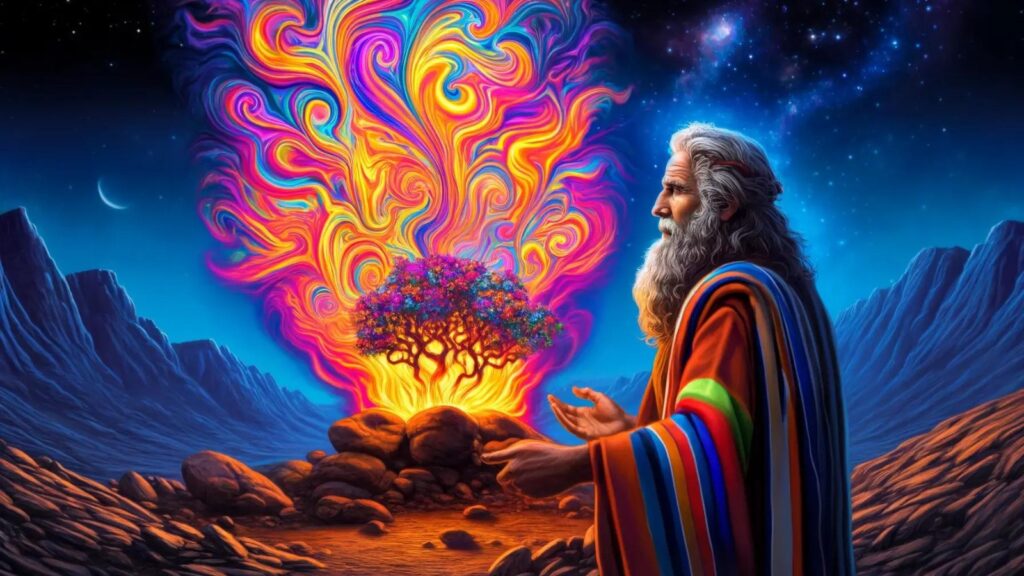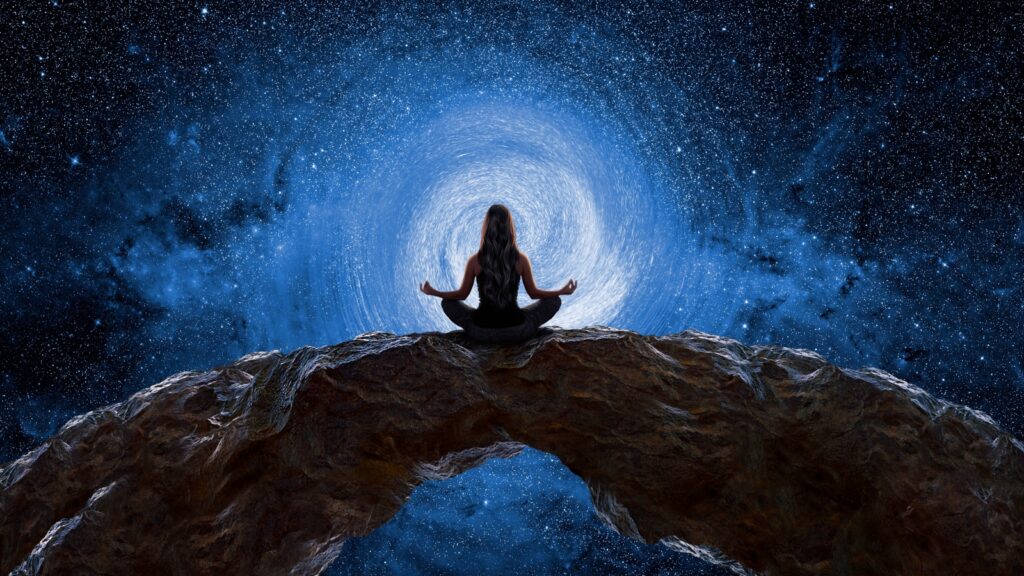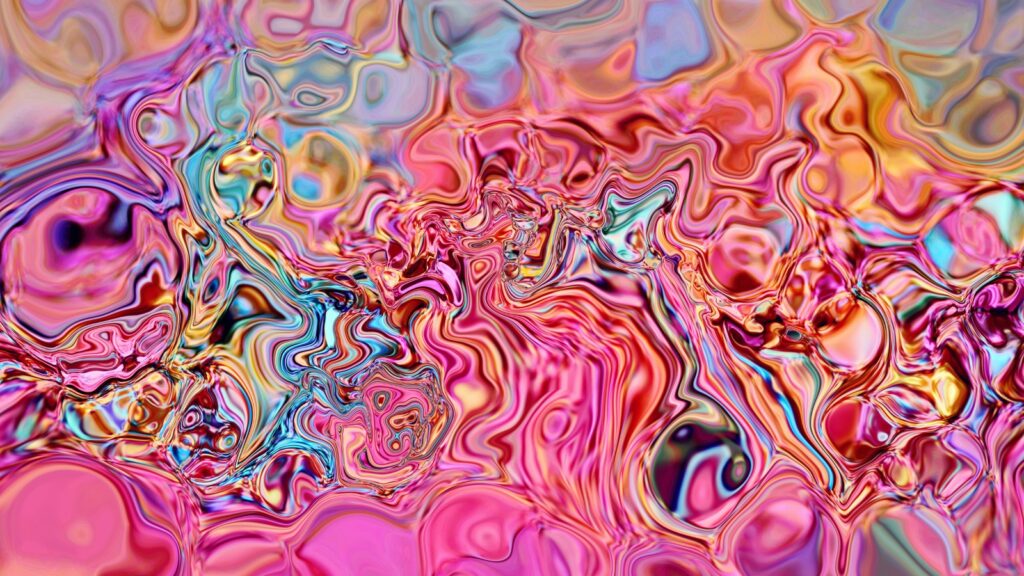The following is excerpted from Tryptamine Palace: 5-MeO-DMT and the Sonoran Desert Toad, published by Inner Traditions.
If we think we can picture what is going on in the quantum domain, that is one indication that we’ve got it wrong. –Attributed to Erwin Schrödinger
May God us keep
From single vision & Newton’s sleep! –William Blake, from a letter to Thomas Butts, November 22, 1802
What began as a studious attempt to understand what happens to me when I smoke 5-MeO-DMT has become — after six years of research — a comprehensive examination of the workings of human consciousness, perception, and ultimately, what the true nature of reality may be. Out of the myriad of extraordinary events that have occurred within the context of my own 5-MeO-DMT experiences, a more limited number of questions regarding the nature of the 5MDE have occupied a central position in my mind. They can be summed up as:
1. What is the source of the brilliant laser-like light that I encounter?
2. How can I feel as if I am occupying a reality outside of time?
3. How can this dimension outside of time seem to contain all possible permutations and information?
4. How can I exist as consciousness without ego or identity, and yet clearly still be me?
5. Why do I so firmly believe that this experience is a recognition and subsequent realization of both the true nature of G/d, and of myself?
My search for answers to these questions led inexorably to the world of quantum physics, a realm that I knew little about other than reading popular accounts, such as Gary Zukav’s book The Dancing Wu-Li Masters, even though I generally found quantum physics intimidating due to my misconception that it involved a lot of applied mathematics. Like most people, I stopped studying math after getting out of high school, and I never had a strong grasp of calculus — my mind just doesn’t work that way. Or perhaps it was simply because of the shifting complexity of the ideas quantum physics presents that I never really could grasp them. But as I followed the leads present in much of the DMT literature –from the McKenna brothers, to Jeremy Narby, to Rick Strassman, and beyond — I repeatedly found myself back in the quantum realm.
Slowly, the collective ideas of a small group of scientific renegades — maverick thinkers such as David Bohm, Rupert Sheldrake, Roger Penrose, Hal Puthoff, Bernard Haisch, and Ervin Laszlo — have effectively helped me to construct a new worldview to replace the old paradigm that my 5-MeO-DMT experiences dissolved away. The obvious similarities between the emerging scientific view of reality and the possibilities implicit in the 5-MeO-DMT experience (and tryptamines in general) have allowed me to feel as if my metaphorical mental feet are returning to somewhat firmer philosophical ground.
We are Homo sapiens, “the knowing man,” animals that prized psychological knowledge over the physical bounties of the Earth, and who — thanks to that same Promethean knowledge — now hold the fate of the planet in our hands. This unquenchable thirst for knowledge, combined with the ingenuity of our modern wonder-tools (such as the particle accelerator, the super computer, and the Hubble telescope), has allowed us over the last twenty years to probe the universe at levels — both great and small — that humanity never previously imagined possible. And the findings that today’s most radical scientists are discovering with these incredible instruments are so strange and unbelievable that it is as if they have come from another dimension. (Which they well may have!) Most of what we were taught about “science” at high school is now turning out to be false; the model we were taught for the atom is as wrong as the model we held for our solar system before Copernicus; and the models we have for the mechanism of consciousness may well be equally as antiquated and naive.
The Trap of Material Realism
Our modern worldview is built on the physical model of the universe provided by Newtonian physics: the idea that all objects in the universe have mass and influence upon each other and that without the influence of this mass, all objects would remain at rest. A good visualization of this is balls on a pool table, which will remain at rest until another ball hits them and sets them in motion. This philosophy, known as material realism, asserts that all bodies in the universe — from pool balls to galaxies — move according to universal laws. This method of thinking laid the groundwork for the belief that all activity in the universe must be caused by knowable laws and formula, the most fundamental of which is Newton’s F = ma (force = mass x acceleration).
The belief that knowing these “universal laws” would enable us to understand all the workings of the universe (from the creation of stars all the way down to our own biological function), as if everything was a complex machine, has led to three centuries of scientific material deconstructionism: a process of breaking everything down to its most basic components in an attempt to prove that these laws were in themselves inescapable. In the process of reducing the mystery of the universe into simple action and reaction — and by ignoring its obvious complexity and interconnectedness –we embraced the belief that by mastering these laws, we could free the human species from the “bonds” of nature.
Ironically, our “faith” in this model of purely random action and reaction has resulted in the dominance of the philosophy that the universe is simply a complex machine, and that we are mere creations of blind chance. This leaves us with the philosophical conundrum that it shouldn’t really make any difference whether we are here or not. And, even though we clearly are here, we are seen as only biological machines, slightly more than robots. Our consciousness is considered to be merely a strange side effect of purely chemical and electrical interactions. A hundred years after killing off God, we’ve concluded that we have no purpose other than “fighting to survive.” We have taken the magic out of the world and reduced it to mere formula, thus allowing our “superior sciences” to deconstruct ourselves.
Modern civilization is built on the foundation of three theories that have become dogma, which we inherited from the three most influential thinkers of the pre-quantum age. From Newton’s equation we concluded that the universe is nothing but a machine; from Darwin we accepted the gospel that man is a creature of chance that has to “fight to survive”; and Descartes convinced us that the physical world of the body and the mental inner world of the mind should be considered as separate entities.
Though they remain unproven, these three ideas are universally accepted. They have been responsible for splitting us off from our planet, from our biosphere, and ultimately from our true selves; embraceing these theories has resulted in the creation of a rabid culture that now threatens the ecological balance of the planet itself. For, as Alvin Toffler says in the introduction to Ilya Prigogine’s Order Out of Chaos (1984), “One of the most highly developed skills in contemporary Western civilization is dissection: the split-up of problems into their smallest possible components. We are good at it. So good, we often forget to put the pieces back together again.”
Since the beginning of the Industrial Revolution we have increased the human population by over five times. We continue to tear the planet to pieces in search of resources that we cannot replenish, while we defile and pollute the rivers, oceans, and even the air we breathe, as we send tens of thousands of species of flora and fauna to extinction — a fate whose door we could soon be knocking on ourselves. The mechanical materialistic model of both humans and the universe as mere machines, has not only destroyed our belief in G/d. As the American philosopher Danah Zohar remarked, “Newton’s vision tore us out from the fabric of the universe itself.”
This paradigm has only been around for the last few centuries, which — even compared to the minor span of human existence as a whole — is a miniscule amount of time. When compared to any kind of geological epoch, it is not even a blink in the eye of the universe. Yet even while our politicians and kings of industry race to further these Newtonian excesses, science — the origin of these destructive simplifications — has moved on to stranger, far less certain ground. This new paradigm of uncertainty and potential, this revolutionary human view of the universe, is called quantum physics.
A Quantum Reality
Ironically it was science’s unquenchable thirst for breaking things into smaller and smaller pieces that ultimately bought the walls of Newtonian physics tumbling down. As our instruments grew more and more powerful, and we began to probe the subatomic realm — the supposed “building blocks” of the universe — scientists came to a staggering realization. In the realm of the very small, Newtonian physics did not hold. In fact, in the realm of the very small, nothing we believed in as solid reality turned out to be true. Solid reality, if we look deep enough, does not seem to exist at all!
To understand how this is possible, we have to comprehend a concept that is central to the ideas of quantum physics. It is called “nonlocality.” It refers to the capacity of quantum particles (such as two electrons) that have once been in contact to retain a connection even when separated — the actions of one will always immediately influence the other, no matter how far apart they are. Today it is widely accepted that, in the subatomic realm, one quantum entity can influence another instantaneously, over any distance, despite there being no exchange of force or energy.
Physicists started moving toward this realization in 1935, when Einstein, along with Boris Podolsky and Nathan Rosen, published a paper — the so-called EPR thought experiment or EPR paradox — that showed that under certain circumstances, quantum mechanics predicted a breakdown of locality. According to this theory, a particle could be put in a measuring device in one location and, through that action alone, would instantly influence another particle an arbitrary distance away. Einstein, Podolsky, and Rosen themselves refused to believe this effect — which Einstein labeled “spooky action at a distance” — and viewed the experiment as evidence that quantum mechanics was incomplete. However, the EPR experiment set the basis for a potential scientific proof of the existence of nonlocality.
Almost thirty years later, J. S. Bell proved mathematically that the results predicted by quantum mechanics could not be explained by any theory that preserved locality. In the forty years that have followed, countless experiments using physical instrumentation have been performed to try to prove the EPR experiment. In the empirical experiments of French physicist Alain Aspect in the 1980s (subsequently replicated in laboratories all over the world), a bizarre thing took place. In the experiments, the correlation of spin state between two particles was maintained — instantaneously — irrespective of how far apart the particles were. (Theoretically this would apply if the two particles were on opposite sides of the universe.) In Aspect’s original experiments, the speed of this transmission was estimated at less than one billionth of a second, about twenty times faster than the speed of light in empty space. In a subsequent experiment performed in 1997 by Nicolas Gisin, it proved to be 20,000 times faster than the speed of light. Many consider these experiments as “proof” of nonlocality. These experiments also obviously put a dent in Einstein’s special theory of relativity, which states that nothing can travel faster than light.
“Teleportation” experiments of the 1990s — where one electron has been “teleported” to another position — have also been cited as “experimental proof” of nonlocality. And in 2004, two independent teams of physicists — one at the National Institute of Standards in Colorado, the other at University of Innsbruck, Austria — announced that they had “teleported” the quantum state of entire atoms. While nonlocality still has its skeptics who state that “sufficient experimental proof” has not been offered, today the concept of nonlocality is assumed to be valid in quantum physics.
This realization was the deathblow for Newtonian physics as a model for the whole universe, since matter could no longer be considered to be individual and separate. Actions did not have to have an observable cause over an observable state. Nothing (at the quantum level) can be considered independent of anything else; all can only be understood in terms of their relationships to each other. The quantum model proposes that the universe exists as an interconnected web of relationships, forever indivisible, since nothing has any meaning by itself!
Our great instruments, which we had built to confirm the solidity of the universe and our concept of the world as a machine built of understandable and predictable parts, now reveal that at its most basic level, the universe is as ethereal and drifting as a dream and as solid as a mirage! Nothing is solid; nothing is real; the universe is a seething field of energy and potential. What is even more astonishing is the realization that we — the living consciousness that observes “reality” — may be the most essential ingredient in this indivisible and interconnected universe. The quantum physicists found something that could have as profound implications for the destiny of the human species as anything we have ever discovered. They found that: “the state of all possibilities of any quantum particle collapsed into a set entity as soon as it was observed or a measurement taken.”
To understand this we have to reexamine the model of the atom we were all taught at school, which is that of electrons orbiting the nucleus like planets going around the sun. This model has been proven to be completely incorrect. What physicists now believe is that a cloud of “potential,” which can cause the electron to materialize in any position, surrounds the nucleus. To visualize this, imagine a race around a track where the runners “appear” at certain spots on the course for a second or two, then disappear and reappear a hundred meters further along — without having to physically cross the distance between the two points. This happens for no apparent reason, nor with any indication as to where they might disappear and appear again. Where this gets really weird, is that some physicists now believe that the “force” causing an electron to appear in some particular position –which is only a possibility and does not have to happen — is the fact that a living consciousness is observing it.
At the subatomic level, where everything is a pulsating sea of electrical charge and possibility, the universe takes physical form (which we call reality) only because we are here to observe it. The act of observation “forces” the electron to appear in a position out of that sea of possibility, and so by observing, we cause “reality” to happen. Just as the Australian Aboriginals believe that their ancestors sang up the world as they walked through the desert, it is possible that through perceiving, we create the universe and everything in it.
These are the main foundations of quantum physics: nonlocality, the fact that the observer cannot be removed from the equation, and that the observer may actually be the reason a particular event occurs at all. At its most basic level, the universe does not operate according to the laws of Newtonian physics; those laws only apply to a small window of the universe we choose to call “our reality.” Once you look past that point, things get peculiar. Energy moves around without apparent rhyme or reason, possessing strange qualities like “charm” and “spin,” while every electron in the universe appears to influence (and be influenced by) every other electron in the universe, through “spooky action at a distance.”
Many of the early contributors to quantum physics — Niels Bohr, Werner Heisenberg, and especially Erwin Schrödinger — realized the profound philosophical implications that their work presented, and they consulted the Kabbalah and Eastern philosophy for help in understanding this new paradigm. But the modern industrial world is built on the foundations of Newton’s physics, as well as the ideas of economic thinkers — such as Adam Smith and John Locke –who followed his mechanist philosophy. And while physics — the cutting-edge of scientific philosophy — moved into the quantum age more than eighty years ago, most other sciences have been moving far slower. Biological systems, for example, were presumed to be dependent on predictable Newtonian laws, and investigations into their quantum nature have only begun in earnest over the past twenty-five years.
As a result, our society has not really considered the profound implications of this totally different view of reality. Yoked to the needs of industry, mainstream science is good at clinging to ideas that it believes it knows, putting things it cannot understand aside for a later day. While we have utilized the breakthroughs that quantum mechanics fostered (such as the processor chip and atomic energy), we have largely ignored the philosophical implications.
Ninety-five percent of modern scientists are highly specialized technicians. They are good at performing a single function, much like a mechanic who can only fix transmissions and does not really know how the whole car operates. Those few scientists who venture outside of the conventions that industry-supported universities allow have often been branded as dangerous mavericks and have been aggressively disavowed (as seen in the fate of Nikola Tesla compared to that of Thomas Edison). Hence, the philosophical implications of quantum physics have mostly been ignored as we hold fast to the dying days of the Newtonian worldview, still treating our severely ailing planet like some kind of machine whose parts we can “fix” when they break down, instead of realizing the truth inherent in the quantum model, which asserts that all life on Earth is interdependent and impossible to regard as anything but a whole.
Only in the last couple of decades has the dominant Newtonian paradigm begun to erode in the sciences outside of physics, thanks to our incredible modern technology, which has produced both the instruments to achieve the results and the computers to crunch the enormous amount of data that has been provided. (More information will be produced by our society in the next twelve months then in the previous 5,000 years! And our technical knowledge is doubling every twelve months!) Quantum relationships are now believed to regulate all processes in the universe, whether it is atoms, cells, galaxies, or even the ultimate human mystery of all: the source of our own consciousness. The most elemental level of living things can no longer be considered as chemical reactions, but as energy.
As Lynne McTaggart explains in her pioneering work The Field:
[Scientists] also discovered that . . . [on] our most fundamental level, living beings, including human beings, were packets of quantum energy constantly exchanging information with [an] inexhaustible energy sea. Living things emitted a weak radiation, and this was the most crucial aspect of biological processes. Information about all aspects of life, from cellular communication to the vast array of controls of DNA, was relayed through an information exchange on the quantum level. Even our minds, that other supposedly so outside of the laws of matter, operated according to quantum processes. Thinking, feeling-every higher cognitive function-had to do with quantum information pulsing simultaneously through our brains and [bodies]. Human perception occurred because of interactions between the subatomic particles of our brains and the quantum energy sea. We literally resonated with our world.
The Implicate Order
The first building blocks of a new philosophical paradigm that could incorporate my 5-MeO-DMT experiences came when I discovered the major works of the British physicist David Bohm. His complex theories of philosophy and physics, most famously expressed in his book Wholeness and the Implicate Order, have drawn praise from spiritual luminaries such as Jiddu Krishnamurti and the Dalai Lama (who called Bohm his “personal physicist”).
Dr. Bohm proposed that mind and matter coexist in different dimensions, unfolding and enfolding upon each other. In principle, then, reality is one unbroken whole — an “implicate order” that includes the entire universe with all its fields and particles. True reality is thus an infinitely multilayered, multidimensional wholeness, while what we typically consider “reality” is only a fragment of the whole. It is more like a dream or an illusion (or even a hallucination), from which our consciousness may one day presumably awake.
This is an extreme simplification of a fully fleshed-out theory of physics by one of the greatest Western minds since Einstein. Bohm’s idea would have been hard for me to even begin to understand if it were not for the fact that it was — up to this point — the best description I had found for what I experience at the peak of a 5MDE. During the peak, I become pure consciousness, with no concept of the normal boundaries of space or time. For that instant, I am a part of the integrated wholeness (where nevertheless I still exist, even though not a shred of my ego or identity remains).
Bohm’s theory is also eerily similar to many Hindu and Buddhist concepts of the true form of the universe and its infinite manifestations. Hindu cosmology depicts the universe as having virtually incalculable size and age, ideas that used to be readily dismissed by Western scholars as deliberate gross exaggeration. However, thanks to instruments like the Hubble telescope, recent discoveries are proving that Hinduism is the only cosmology that is even close, while the Greeks, Christians, Arabs, and others had all massively underestimated.
According to David Bohm, matter is “condensed or frozen light.” Therefore, the entire physical world can be regarded as ordered forms of slow-moving light. This includes all organic life, whose existence and survival is entirely sustained by light energy from the sun. Life on this planet is a continuing process of light evolving itself into more complex forms of order: first into the simplest of atoms and molecules, then into increasingly complex forms of matter, then into exponentially more complex organic life forms (thanks to the wonders of DNA and RNA), and now-most recently, in our world at least — the latest evolution into conscious, questioning life forms.
The process of exponentially increasing complexity of order in a (supposedly) closed system (which should be increasing in disorder) is called negentropy. This process directly contradicts the second law of thermodynamics, which states that all isolated systems must move from a state of order toward a state of chaos (entropy). According to the Newtonian paradigm, this highly improbable complex ordering of light has been the result of purely random interactions. However, since the advent of the quantum sciences and the invention of the tremendous number-crunching computers of recent years, some scientists have begun to suspect that the mechanisms of “life, the universe, and everything” (with apologies to Douglas Adams!) are much too balanced and finely tuned to have been able to evolve by blind chance alone.
According to calculations by Roger Penrose, for example, the probability of the evolution of our particular universe by a random selection from among the alternative-universe possibilities is one in 10 to the power of 10 to the power of 123! This is an inconceivably large number, indicating an improbability of astronomical proportions! The universe is turning out to be so complicated, in fact, that — according to David Bohm’s theories — it requires the existence of a superior or implicate order of organization that defines the physical principles of our universe and governs all known physical processes, including ourselves.
Image by Aetas Serenus, courtesy of Creative Commons license.









